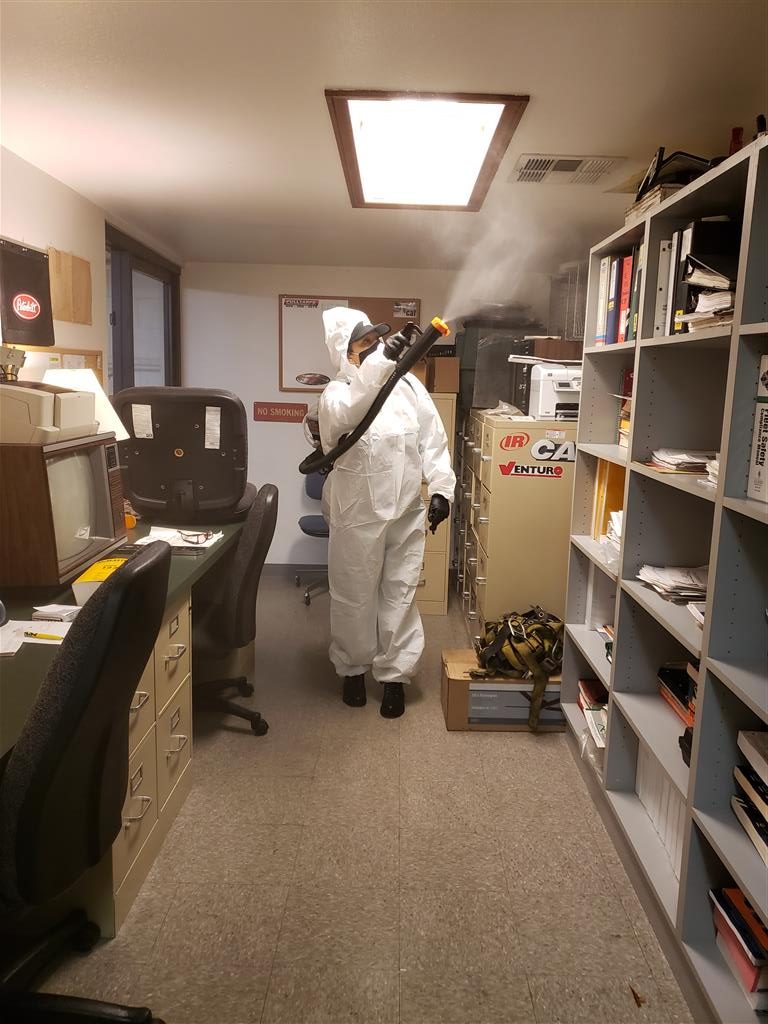Electrostatic spray is electrically charged, allowing the appropriate sanitizers, mold COVID-19 and other airborne and high touch areas preventatives and disinfectants to wrap around and evenly coat all types of surfaces for a more complete clean. As the chemical exits the electrostatic sprayer, it’s given a positive electrical charge.
What Is Electrostatic Disinfection and How Does It Work?
When it comes to cleaning surfaces and objects, traditional dry and wet dusting tends to be the first methods that come to mind. While these cleaning techniques are tried and true, they do little more than spread filth around, unless the rags used are washed regularly. Dry dusting kicks up resting particles, redistributing them into the air and onto other surfaces. Wet dusting can involve harmful cleaning chemicals and make it hard to reach certain spots or objects. For sensitive places, like clean rooms, R&D labs, healthcare facility cleaning and schools, there’s a more effective method for stripping dirt, dust and germs from surfaces that require specialized sanitation: electrostatic spray.
Looking for information on Coronavirus (COVID-19)? Visit our helpful Coronavirus page.
What Is Electrostatic Disinfection?
Electrostatic spray surface cleaning is the process of spraying an electrostatically charged mist onto surfaces and objects. Electrostatic spray uses a specialized solution that is combined with air and atomized by an electrode inside the sprayer. Subsequently, the spray contains positively charged particles that are able to aggressively adhere to surfaces and objects. Because the particles in the spray are positively charged, they cling to and coat any surface they’re aimed at.
For awkwardly shaped objects or hard to reach places, cleaning staff only have to point and spray; the nature of the mist allows it to coat surfaces evenly, and envelope objects—even if the mist is only sprayed from one side. After the spray is applied, the sanitizing agent works to disinfect the covered surfaces. For this reason, electrostatic spray is an excellent solution for germ and contaminant ridden areas.
How Does Electrostatic Disinfection Work?
Electrostatic spray is electrically charged, allowing the appropriate sanitizers, mold preventatives and disinfectants to wrap around and evenly coat all types of surfaces for a more complete clean. As the chemical exits the electrostatic sprayer, it’s given a positive electrical charge. The droplets then become attracted to all negative surfaces, covering the visible area, underside and backside, with the sanitizing agent. Surfaces that are already covered will repel the spray, making the method extremely efficient.
Is Electrostatic Spray Disinfection Right For My Business?
If your building contains rooms or areas that are sensitive to grime and germs, such as R&D facilities or clean rooms, then yes, electrostatic spray cleaning is the best option for cleaning all the surfaces and equipment in that room. Although electrostatic spray may sound like an aggressive method for regular commercial cleaning applications, the opposite is true.
The main features and benefits of electrostatic spray disinfection includes:
Reduces the time it takes to cover and disinfect all surfaces and hard-to-reach places by 50% compared to conventional methods.
Improves infection control and the spread of viruses such as influenza, MRSA, HIV and many others.
Applies chemicals in a more efficient, controlled manner, eliminating the dangers of overuse.
Prevents costly financial burdens associated with contagious healthcare infections.
For desktops, floors and walls that need to be absolutely spotless, electrostatic spray cleaning is the best option. The same goes for equipment and hard to reach places; if a piece of equipment is heavily trafficked, electrostatic spray cleaning in the most comprehensive way to remove germs and dirt.
Interested in learning more about electrostatic spray disinfection technology and how it would benefit your building? Contact the most trusted electrostatic disinfection cleaning corporation today.







